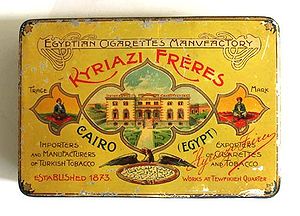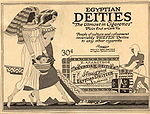
Egyptian cigarette industry
Encyclopedia

Export
The term export is derived from the conceptual meaning as to ship the goods and services out of the port of a country. The seller of such goods and services is referred to as an "exporter" who is based in the country of export whereas the overseas based buyer is referred to as an "importer"...
industry
Industry
Industry refers to the production of an economic good or service within an economy.-Industrial sectors:There are four key industrial economic sectors: the primary sector, largely raw material extraction industries such as mining and farming; the secondary sector, involving refining, construction,...
that influenced global fashion
Fashion
Fashion, a general term for a currently popular style or practice, especially in clothing, foot wear, or accessories. Fashion references to anything that is the current trend in look and dress up of a person...
. It was notable as a rare example of the global periphery
Periphery countries
In World Systems Theory, the periphery countries are those that are less developed than the semi-periphery and core countries. These countries usually receive a disproportionately small share of global wealth. They have weak state institutions and are dependent on – according to some, exploited...
setting trends in the global center in a period when the predominant direction of cultural influence was the reverse, and also as one of the earliest producers of globally traded manufactured finished goods outside the West.
Rise
The development of a major cigarette industry in Egypt in the late nineteenth century was unexpected, given that Egypt generally exported raw materials and imported manufactured goods, that Egyptian-grown tobacco was always of poor quality, and that the cultivation of tobacco in Egypt was anyhow banned in 1890 (a measure intended to facilitate the collection of taxes on tobacco).One reason for the development of the industry was the imposition of a state tobacco monopoly
Monopoly
A monopoly exists when a specific person or enterprise is the only supplier of a particular commodity...
in the Ottoman Empire
Ottoman Empire
The Ottoman EmpireIt was usually referred to as the "Ottoman Empire", the "Turkish Empire", the "Ottoman Caliphate" or more commonly "Turkey" by its contemporaries...
, a measure designed to increase Ottoman government revenue. This resulted in the movement of many Ottoman tobacco merchants, usually ethnic Greeks
Greeks
The Greeks, also known as the Hellenes , are a nation and ethnic group native to Greece, Cyprus and neighboring regions. They also form a significant diaspora, with Greek communities established around the world....
, to Egypt, a country which was culturally similar to the Ottoman Empire but outside the tobacco monopoly as a result of its occupation
Imperialism
Imperialism, as defined by Dictionary of Human Geography, is "the creation and/or maintenance of an unequal economic, cultural, and territorial relationships, usually between states and often in the form of an empire, based on domination and subordination." The imperialism of the last 500 years,...
by the United Kingdom
United Kingdom
The United Kingdom of Great Britain and Northern IrelandIn the United Kingdom and Dependencies, other languages have been officially recognised as legitimate autochthonous languages under the European Charter for Regional or Minority Languages...
.

Khairy Pasha palace
Khairy Pasha palace is a neo-Malmuk palace residence built near Midan Ismaileyya square in 19th century Cairo, Egypt. It is now within the present day Tahrir Square area on Qasr el-Nil Street, and has been incorporated into the American University in Cairo Tahrir Square campus - 'AUC Downtown'...
in Cairo which, after Gianaclis moved to larger premises in 1907, became the home first of Cairo University
Cairo University
Cairo University is a public university located in Giza, Egypt.The university was founded on December 21, 1908, as the result of an effort to establish a national center for educational thought...
and then of the American University in Cairo
American University in Cairo
The American University in Cairo is an independent, non-profit, apolitical, secular institution of higher learning located in Cairo, Egypt...
. Gianaclis and other Greek industrialists such as Ioannis Kyriazis of Kyriazi frères
Kyriazi freres
Kyriazi Freres was a cigarette manufacturing company established in 1873 in Egypt...
successfully produced and exported cigarettes using imported Turkish tobacco to meet the growing world demand for cigarettes in the closing decades of the nineteenth century.
Egyptian cigarettes made by Gianaclis and others became so popular in Europe and the United States that they inspired a large number of what were, in effect, locally-produced counterfeit
Counterfeit
To counterfeit means to illegally imitate something. Counterfeit products are often produced with the intent to take advantage of the superior value of the imitated product...
s. Among these was the American Camel
Camel (cigarette)
Camel is a brand of cigarettes that was introduced by American company R.J. Reynolds Tobacco in the summer of 1913. Most current Camel cigarettes contain a blend of Turkish tobacco and Virginia tobacco. Early in 2008 the blend was changed as was the package design.-History:In 1913, R.J...
brand, established in 1913, which used on its packet three Egyptian motifs: the camel
Camel
A camel is an even-toed ungulate within the genus Camelus, bearing distinctive fatty deposits known as humps on its back. There are two species of camels: the dromedary or Arabian camel has a single hump, and the bactrian has two humps. Dromedaries are native to the dry desert areas of West Asia,...
, the pyramids, and a palm tree.
Decline
Tastes in Europe and the United States shifted away from Turkish tobacco and Egyptian cigarettes towards Virginia tobaccoHistory of commercial tobacco in the United States
The history of commercial tobacco production in the United States dates back to the 17th century when the first commercial crop was planted. The industry originated in the production of tobacco for pipes and snuff. Different war efforts in the world created a shift in demand and production of...
, during and after the First World War. What remained of the Greek-run tobacco industry in Egypt was nationalized after the Egyptian Revolution
Egyptian Revolution
Egyptian revolution may refer to:* Egyptian revolution of 2011, a series of mass popular protests leading to the resignation of Hosni Mubarak* Egyptian revolution of 1952, led by Muhammad Naguib, Gamal Abdel Nasser, and the Free Officers Movement...
of 1952. Egyptian-made cigarettes were thereafter sold only domestically, and became known for their poor quality (and low price).
Of all the many foreign imitations of Egyptian cigarettes, only Camel survived the remainder of the twentieth century.
In culture
Arthur Conan DoyleArthur Conan Doyle
Sir Arthur Ignatius Conan Doyle DL was a Scottish physician and writer, most noted for his stories about the detective Sherlock Holmes, generally considered a milestone in the field of crime fiction, and for the adventures of Professor Challenger...
paid a casual tribute to the popularity of Egyptian cigarettes in his 1904 story "The Adventure of the Golden Pince-Nez
The Adventure of the Golden Pince-Nez
"The Adventure of the Golden Pince-Nez", one of the 56 Sherlock Holmes short stories written by British author Sir Arthur Conan Doyle, is one of 13 stories in the cycle collected as The Return of Sherlock Holmes.-Synopsis:...
", where a character interviewed by Sherlock Holmes
Sherlock Holmes
Sherlock Holmes is a fictional detective created by Scottish author and physician Sir Arthur Conan Doyle. The fantastic London-based "consulting detective", Holmes is famous for his astute logical reasoning, his ability to take almost any disguise, and his use of forensic science skills to solve...
in a murder investigation is described as a very heavy consumer of them.
- "A smoker, Mr. Holmes?" said he, speaking in well-chosen English, with a curious little mincing accent. "Pray take a cigarette. And you, sir? I can recommend them, for I have them especially prepared by Ionides, of Alexandria. He sends me a thousand at a time, and I grieve to say that I have to arrange for a fresh supply every fortnight.
His cigarette ash eventually helps Holmes solve the mystery.
Egyptian cigarette advertisements are parodied in Herge
Hergé
Georges Prosper Remi , better known by the pen name Hergé, was a Belgian comics writer and artist. His best known and most substantial work is the 23 completed comic books in The Adventures of Tintin series, which he wrote and illustrated from 1929 until his death in 1983, although he was also...
's graphic novel Cigars of the Pharaoh
Cigars of the Pharaoh
Cigars of the Pharaoh is one of The Adventures of Tintin, a series of classic comic-strip albums, written and illustrated by Hergé, featuring young reporter Tintin as a hero...
. Tintin
Tintin
Tintin, Tin-Tin or Tin Tin may refer to:* The Adventures of Tintin , the series of classic comic books created by Belgian artist Hergé...
has a nightmare where characters in ancient Egyptian garb smoke opium-laced cigars.

